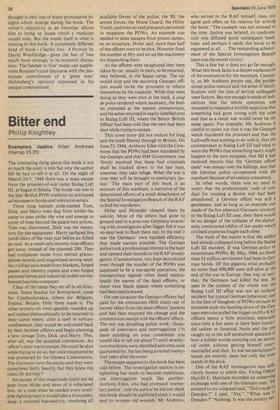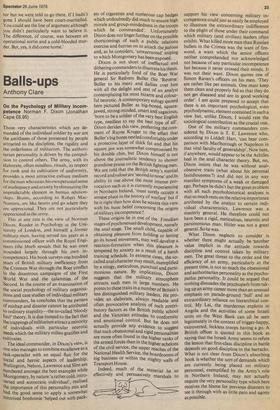Bitter end
Phillip Knightley
Exemplary Justice Allen Andrews (Harrap £5.25)
The interesting thing about this book is not so much the story it tells but why the author felt he had to tell it at all. On the night of
March 24-5, 1944 there was a mass escape from the prisoner-of-war camp Stalag Luft III, at Sagan in Silesia. The break-out was in the best British POW tradition as portrayed ad nauseamin books and television serials.
Three long tunnels code-named Tom, Dick, and Harry were dug from within the camp to pass under the wire and emerge in cover of trees beyond the guard-box pylons.
Tom was discovered, Dick was the repository for the equipment. Harry surfaced five yards short of the trees just before an Allied air raid. As a result only seventy-nine officers got away instead of the planned 200. They had compasses made from melted gramo phone records and magnetised sewing needles, civilian suits made from blankets, forged passes and identity papers and even forged personal letters and industrial orders on embossed business notepaper.
Clear of the camp they set off in all directions. Some headed for Switzerland, some for Czechoslovakia, others for Belgium, France, Britain. Only three made it. The other seventy-six were speedily rounded up and waited philosophically to be returned to
their camp where, after a spell in solitary confinement, they would be welcomed back
by their brother officers and begin planning a new vintage Tom, Dick, and Harry. This, after all, was the accepted convention. An officer's duty was to escape. He could be shot while trying to do so, but once recaptured he was protected by the Geneva Conventions.
The Germans were the enemy and they were sometimes fairly beastly, but they knew the rules. Or did they ?
An escape of this magnitude could not be kept from Hitler and news of it infuriated
him. At a time when he needed every available fighting man it would take a Grosslahndung, a national hue-and-cry, involving all
available forces of the police, the SS, the armed forces,. the Home Guard, the Hitler Youth, and even air raid precation personnel to recapture the POWs. An example was needed to deter escapes from prison camps, so on recapture. Hitler said, more than half of the officers were to be shot. Himmler fixed the number at fifty and set up the machinery for dispatching them.
As the officers were recaptured they were taken by car, usually in pairs, to be returned, they believed, to the Sagan camp. The car would stop and the escorting Gestapo officers would invite the prisoners to relieve themselves by the roadside. While they were doing so they were shot in the back, a coup de grace rendered where necessary, the bodies cremated at the nearest crematorium, and the ashes returned in neatly-labelled urns to Stalag Luft III, where the Senior British Officer had been told that the men had been shot while trying to escape.
This cover story did not endure for long and the truth filtered through to Britain. On June 23, 1944, Anthony Eden told the Commons that the POWs had been murdered by the Gestapo and that HM Government was 'firmly resolved that these foul criminals shall be tracked down to the last man, wherever they take refuge. When the war is over they will be brought to exemplary justice.' The main part of this book is an account of this manhunt, a narrative of the determined efforts of a small detachment of the Special Investigation Branch of the RAF to find the murderers.
Hitler and Himmler cheated them by suicide. Most of the others had gone to ground and in a post-war Germany swarming with investigators after bigger fish it was no easy task to flush them out. In the end it was the Germans' own vaunted efficiency that made success possible. The German police took a professional interest in the hunt and opened their records to the RAF investigators. Crematoriums, too, kept records and even though the murder of the POWs was supposed to be a top-secret operation, the crematorium register often listed meticulously the names of the dead officers, or there were blank spaces where something had been neatly erased.
On one occasion the Gestapo officers had paid for the cremations (fifth class) out of money taken from the dead officers' pockets and had then returned the change and the crematorium receipt with the officers' effects. The rest was plodding police work: thousands of interviews and interrogations ('Is there anything on your conscience you would like to tell me about ?') until seventytwo murderers were identified and sixty-nine accounted for, the last being arrested twentyfour years after the event.
The escape sequence in this book has been told before. The investigation section is en lightening but tends to become repetitious,
one interrogation much like another. Anthony Eden, who had promised 'exemp
lary justice', told the author he did not think this book should be published since it would tend to re-open old wounds. Mr Andrews,
who served in the RAF himself, does not agree and offers us his reasons for writing the book: 'The example was not stressed at the time. Justice was belated, its confirmation was diffused amid subsequent headlines, and perhaps it needs this book to be registered at all ... The resounding achievement of the Special Investigation Branch team was the moral victory'.
This is fine but it does not go far enough. What this book lacks is a deeper explanation of the motivation for the manhunt. Certainly, as Mr Andrews points out, the professional police instinct and the sense of identification with the fate of service colleagues were factors. But not enough is made of indications that the whole operation was mounted to reassure a terrible suspicion that something had gone wrong with the rules and that as a result war would never be the same again. For example, Mr Andrews is careful to point out that it was the Gestapo which murdered the prisoners and that the Luftwaffe had nothing to do with it, that the commandant at Stalag Luft III had tried to warn the POWs that something nasty might happen to the next escapees, that MI 6 had received reports that the 'German officer caste' was uneasy over the killings, and that the German police co-operated with the manhunt because of an uneasy conscience.
In other words, there was no need to worry that the professionals' code of cooduct for running a decent war had been abandoned, a German officer was still a gentleman, and as long as an example was made of the few aberrant Germans involved in the Stalag Luft III case, then there would be no danger of the collapse of the elaborately constructed edifice of law under which civilised countries fought each other.
The truth of the matter is that the edifice had already collapsed long before the Stalag Lull III murders. It was German policy to exterminate POWs. By May, 1944, no fewer than 51 million servicemen had been in German hands. Of this gigantic total probablY no more than 800,000 were still alive at the end of the war in Europe. One way or another, the Germans had killed the rest. So seen in the context of the whole war the Stalag Luft III affair was not an isolated incident but typical German behaviour, and in the face of slaughter of POWs on such an immense scale the hunting down of the Gestapo men who pulled the trigger on fifty RAF officers seems a little pointless, especiallY since only a few seem to have been homicidal sadists or fanatical Nazis and the rest,. caught up in the still unresolved question 01 how a soldier avoids carrying out an immoral order without getting himself emir!' martial led and shot. In war no participant 5 hands are entirely clean but only the loser stands in the dock.
One of the RAF investigators was sufficiently honest to admit this. Flying Officer
Harold E. Harrison recorded an unnerving
exchange with one of the Gestapo men. 'Fle pointed to my wing and said, "Did you got) Dresden ?" I said, "Yes." "What was 111 Dresden ?" Nothing. It was the pottery sec'
tor but we were told to go there. If I hadn't gone I should have been court-martialled. You could see the line of argument although you didn't particularly want to believe it. The difference, of course, was between an operational sortie and a cold-blooded murder. But, yes, it did come home.'















































 Previous page
Previous page